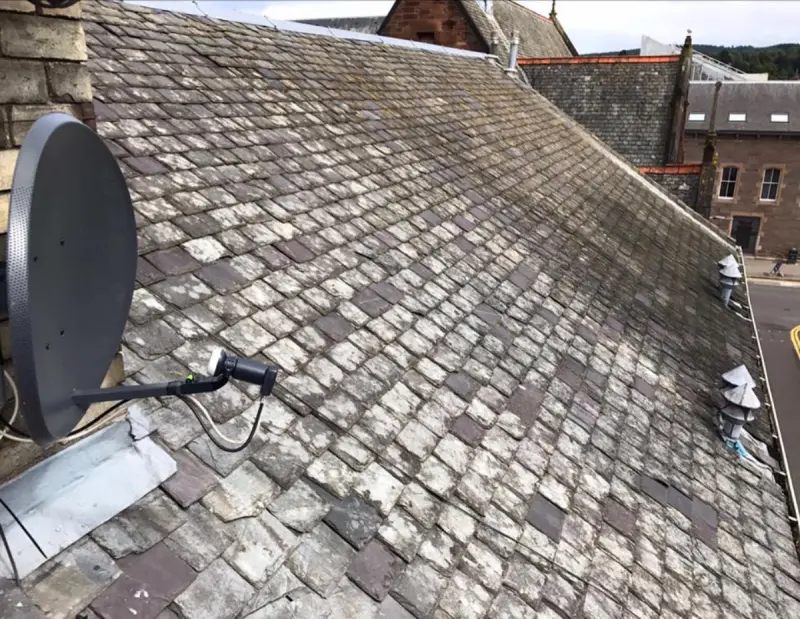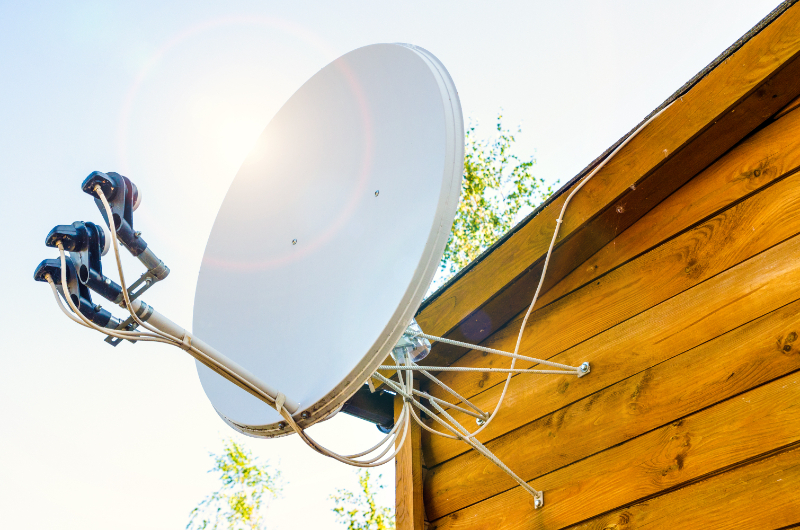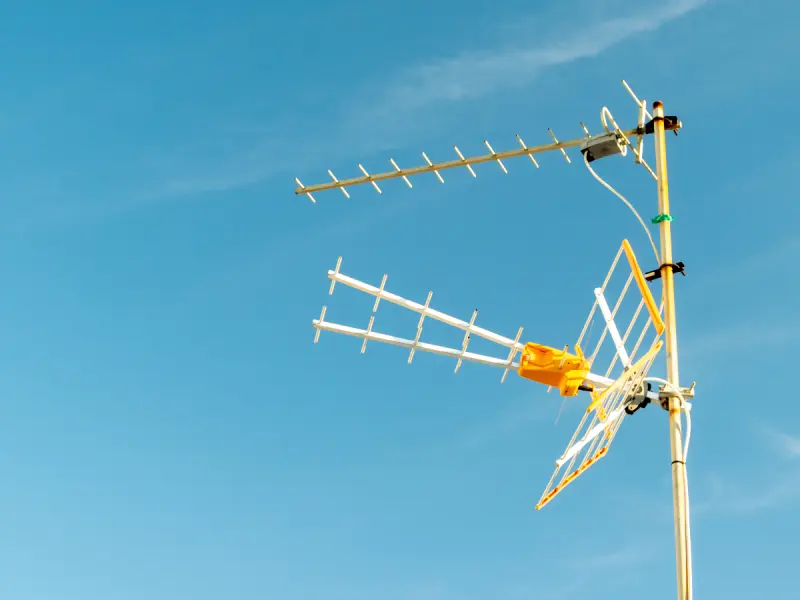Have you been considering loft aerials vs outdoor aerials? We look at the advantages and disadvantages of each type of aerial installation. Fair City Aerial & Digital TV Services offer satellite & TV aerial installation throughout Perth, Perthshire and Tayside.
Benefits Of Roof Mounted TV Aerials
Enhancing your television experience hinges on your choice of aerial installation. Opting for a roof-mounted TV aerial brings forth benefits that significantly influence signal quality and enjoyment. Here's why roof-mounted TV aerials are a preferred option for many UK households:
Placing your TV aerial on the roof provides an elevated vantage point, ensuring improved signal reception. This minimises potential obstructions, resulting in a more stable and clear broadcast.
Roof-mounted aerials benefit from an extended signal range, particularly beneficial in areas with weak signal coverage or geographical interference. Roof placement minimises sources of interference like walls and trees, leading to a reliable signal and reduced disruptions during shows. Better signal reception allows exploration of various free-to-air channels, expanding entertainment choices.
Roof installations consider evolving broadcasting technology. You'll be prepared for new channels and standards without frequent adjustments. Aerials discreetly positioned above preserve your property's aesthetics without compromising signal quality.
Roof-mounted installations are secure and less prone to damage, offering reliable entertainment for years. Roof installations may require professional expertise, to ensure secure mounting and optimal reception alignment.
Opting for a roof-mounted TV aerial enhances your viewing experience with improved signal reception, an extended range, and reduced interference. Access to a wider range of channels, aesthetic appeal, longevity, and professional installation complete the package. For an elevated TV-watching experience, considering a roof-mounted installation proves advantageous.
Downsides Of Roof Mounted TV Aerials
Roof-mounted TV aerials offer advantages, but they also come with drawbacks to consider. Installation complexity, potential aesthetic impacts, weather exposure, and signal interference are factors to bear in mind. These installations may require more time and expertise due to their height and specialised equipment. The external presence of the aerial might affect your property's visual appeal.
Weather elements can cause wear and tear over time, affecting performance. Signal interference from metal roofs or obstructions could disrupt reception. Regular maintenance, safety precautions, and potential impacts on property value should also be considered.
Complying with regulations and planning permissions is essential. Weigh these factors to decide if roof-mounted installation is the right choice for your home's TV reception needs.

Benefits Of Roof Mounted TV Aerials

Downsides Of Roof Mounted TV Aerials
Benefits Of Loft Aerial Installation
The choice of TV aerial installation location significantly impacts your signal quality and overall television experience. Opting for a loft-mounted TV aerial presents a range of benefits that can enhance your viewing satisfaction. Here's why many homeowners in the UK prefer loft aerial installation:
Installing a TV aerial in the loft eliminates the need for external mounting, making the process more accessible and cost-effective. With no need for external fixtures or extra equipment, installation expenses can be reduced. The protection offered by the loft against the elements contributes to a longer lifespan for the aerial, potentially saving on maintenance and replacement costs over time. Additionally, the discreet indoor placement of loft aerials maintains your property's external appearance.
Loft installations are less susceptible to signal interference caused by physical obstructions like buildings or trees. This translates to a stable and reliable signal, ensuring a better viewing experience. The resilience of loft installations against harsh weather conditions ensures consistent signal reception, even during adverse weather. This minimises signal disruptions, allowing uninterrupted viewing enjoyment.
Furthermore, the secure indoor placement of loft-mounted aerials adds an extra layer of security, reducing the risk of theft or tampering. In terms of cost, loft aerial installation can be a cost-effective alternative to more complex external setups. The absence of external fixtures and ease of access contributes to reduced installation expenses. Loft aerial installation is especially beneficial in areas where external mounting is challenging due to property restrictions. It offers a solution that enables quality signal reception without extensive external fixtures.
Lastly, loft installations allow for more straightforward adjustments or upgrades compared to external setups. If changes in technology or broadcasting standards occur, adapting your setup is easier. Opting for a loft-mounted TV aerial installation offers numerous advantages that contribute to an enhanced television viewing experience. From accessibility and weather protection to reduced signal interference and cost savings, the benefits are substantial. If you're looking for a practical and efficient way to achieve quality signal reception without compromising your property's external appearance, loft aerial installation is a valuable choice to consider.
Downsides Of Loft Aerial Installation
Despite its advantages, loft aerial installation also comes with certain downsides that you should take into account when deciding on the best installation method for your TV aerial. Understanding these drawbacks can help you make an informed choice that aligns with your specific requirements. Here are some potential downsides associated with loft aerial installation:
Placing the aerial inside the loft can sometimes lead to signal interference caused by obstacles within your home, such as walls, furniture, or electronic devices. This interference can negatively impact signal quality, resulting in pixelation or poor reception on your TV. Loft installations might experience weaker signal strength compared to external setups, especially in areas with poor signal coverage. This weaker signal strength could result in suboptimal picture quality and interruptions in your viewing experience.
The type of roofing materials used in your property can affect signal reception. Metal roofs or thick roofing materials might impede the signal, leading to reduced signal strength and potential signal loss. Loft installations might not be as adaptable to future changes in broadcasting technology or standards as external setups. If such changes occur, adjustments to your setup might be necessary to ensure consistent signal reception.
While loft installations are generally more accessible, they still require technical expertise and precise alignment for optimal signal reception. Incorrect installation could result in poor signal quality, necessitating troubleshooting. Loft installations could limit your choice of aerial types, potentially affecting the range and quality of signals received.
External installations might provide more flexibility in selecting the appropriate aerial for your needs. Aerials placed in the loft may require periodic maintenance due to dust, debris, or potential adjustments. Even though the aerial is shielded from external elements, proper upkeep is necessary to ensure consistent signal reception.

Benefits Of Loft Aerial Installation

Downsides Of Loft Aerial Installation
Which Type Of Aerial Installation Is Better?
When faced with the decision of choosing between roof-mounted and loft TV aerial installations, it's important to recognise that the answer isn't a straightforward one. Instead, the choice hinges on a variety of factors that are unique to your circumstances and preferences. In the following sections, we'll delve into key considerations that can aid in determining which type of aerial installation might be better suited for your specific needs.
Signal Strength & Quality: At its core, the purpose of a TV aerial is to deliver a strong and clear signal for optimal TV reception. If you find yourself residing in an area with a robust signal, both roof-mounted and loft installations could feasibly provide satisfactory results. However, if your location contends with a weaker signal, a roof-mounted aerial may hold an advantage due to its elevated position, potentially resulting in better line-of-sight communication with broadcasting towers.
Aesthetic Preferences: The visual impact of an external aerial on the overall appearance of your property is a critical aspect to consider. If maintaining the aesthetics of your home is a priority, the option of a loft installation might prove more enticing, as it discreetly conceals the aerial from plain sight. On the other hand, a roof-mounted aerial might be more conspicuous but could potentially offer superior signal reception capabilities.
Installation Complexity: It's worth noting that roof-mounted installations often come with increased complexity due to the necessity of working at heights and potential exposure to adverse weather conditions. In contrast, loft installations generally boast a simplified and more straightforward process. If concerns surrounding installation intricacies arise, a loft installation might be the more appealing choice.
Weather Exposure: Roof-mounted aerials are subjected to the elements, which can lead to wear and tear over time. Conversely, loft installations benefit from being shielded from various weather conditions, potentially contributing to an extended aerial lifespan.
Access and Safety: The realm of roof-mounted installations entails working at elevated heights, inherently carrying safety risks. In contrast, loft installations eliminate this particular concern, rendering them a safer alternative for both installation and subsequent maintenance procedures.
Cost: Costs associated with aerial installations can fluctuate based on an array of variables, including installation type, geographical location, and requisite materials. As a rule of thumb, loft installations are often more budget-friendly due to their simplified nature and reduced equipment demands.
Discover unparalleled TV Services in the heart of Perthshire. Fair City Aerial & Digital TV Services offers top-tier installations, signal optimisations, and the latest digital advancements in and around Perthshire.



